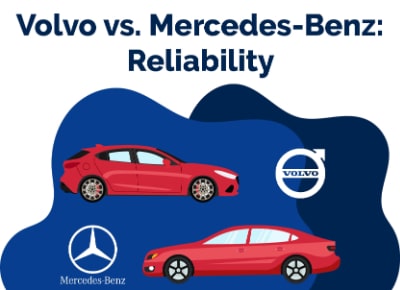Volvo vs. Mercedes Reliability: A Detailed Comparison
February 7, 2024


I am a serial entrepreneur and a consumer advocate. When I’m not helping car buyers, I love working on ventures that have a positive impact.
I run a cause marketing agency and serve on the board of Vayu Global Health where we are disrupting the medical industry and preventing the needless deaths of mothers and babies during childbirth.
Choosing between Volvo and Mercedes-Benz? It's all about reliability.
In this head-to-head comparison, we dissect what sets these automotive giants apart and which is more reliable. Volvo shines with top-notch safety and value retention, while Mercedes impresses with luxury and tech.
Overall, Volvo is more reliable than Mercedes because it has a lower maintenance cost and better performance.
Dive into our detailed analysis to see why Volvo leads the reliability race.
Key Takeaways
- When comparing several factors, Volvo is more reliable than Mercedes.
- Volvo stands out for its advanced safety features and higher resale value, making it a practical choice for safety-conscious buyers
- Mercedes-Benz is renowned for its luxurious design and cutting-edge technology, appealing to those who prioritize sophistication
- Ultimately, the choice between Volvo and Mercedes-Benz depends on individual preferences for safety, luxury, technology, and overall value.
Table of Contents
Volvo vs. Mercedes Reliability
Here’s a detailed review of the Volvo vs. Mercedes reliability comparison and why Volvo is more reliable.
| Features | Volvo | Mercedes |
| Design | Simple design. | Class: a good definition of luxury. |
| Repairs and Maintenance Cost | ||
| Durability | ||
| Gas Mileage | ||
| Technology | ||
| Safety |
Which Is Better Between Volvo and Mercedes?
Volvo is more reliable than Mercedes.
On the 2023 JD Power Dependability Study, Volvo ranked 24 with 215 problems per 100 vehicles, and Mercedes ranked 28 with 240 problems per 100 vehicles.
In an overall comparison, it’s clear that Volvo prioritizes safety and durability while Mercedes prioritizes design.
Most times, it’s a choice of personal preference. With Volvo, you are assured of power, strength, and durability. Those who love flashy cars with speed and a sporty feel may prefer Mercedes.
Gas Mileage
Volvo and Mercedes present excellent fuel economy and gas mileage. For an accurate winner, you must evaluate specific models.
The Mercedes-Benz C-class, GLA model, CLA, E, and A class are production's most fuel-efficient Mercedes models. The Mercedes C-Class features a gas mileage of 64.2 mpg, with the C300 e and C 300 de that runs on hybrid technology hitting impressive heights with fuel economy.
The Mercedes GLA returns 49.6mpg, Mercedes-Benz CLA electric achieves up to 44 miles on a full charge. The E and A Mercedes classes juggle 62.8mpg and 56.5-58.9 mpg, respectively.
Volvo hits impressive MPG as a fuel-efficient car. We have the Volvo S60, V90, S90, V60, XC90, XC60, T8, and T6 twin-engine, from 134.5 mpg to as high as 141.2 mpg.
Yes, these cars are hybrid or electric. However, there are regular Volvos with petrol engines, like the Volvo XC90, returning a gas mileage of 84.677mpg.
Winner: Both
Design
Both car brands feature an all-wheel-drive and 4-wheel-drive system. The differences in design lie in the design initiative of both manufacturers.
Volvo’s Durable Designs
They keep it simple and unique. Volvo maintains plain designs but lends its designs with durability.
Volvo’s design is specifically made to handle challenging and uneven terrains. There are skid plates to safeguard the car from collision and a reinforced body shell for superior strength.
Some of Volvo's models come with special composite tires. Its wheel strength design also keeps it on the go for long hours.
Mercedes Flashy Designs
Mercedes features a flashy and attractive body design. Mercedes are a great definition of luxury with designs that stand out.
Most of its tires are made with simple and good polymeric materials that function well.
Mercedes is the type of car you will want to drive to an event, and everyone turns to scream, “Hey, that’s a beauty! Which brand is that?”
Winner: Mercedes
Cost Of Maintenance And Repair
The cost of maintenance and repair is cheaper with Volvo compared to Mercedes.
The average annual repair and maintenance cost for Volvo is $769. This is cheaper than Mercedes, which has an annual repair cost of $908.
With a Volvo, you also have a lesser chance of going for repairs. However, your driving conditions and maintenance culture play a major role.
Winner: Volvo
Durability
Volvos are more durable than Mercedes.
Some users describe Volvo as a car that lasts for eternity. Their vehicles feature a strong frame, reinforced body, and high-quality materials that make them go the extra mile,
On average, Volvos last for as long as 200,000 to 250,000 miles with about 20 years of thorough usage. This is pretty impressive as it goes higher than Mercedes, whose durability ranges from 150,000 to 200,000 miles with 10 years of regular usage.
Volvo’s increased longevity does not mean that Mercedes are below quality. With quality overall car structure, Mercedes does build solid cars that you can rely on (just not as long as Volvos).
Winner: Volvo
Technology
Mercedes and Volvo both have impressive technology packages.
For example, Mercedes has an active stop-and-go technology that helps it to distance itself from the cars in front of it. There's also the exit warning function and cross-traffic function. This is also present in Volvo.
Mercedes has the Energizing coach, fully variable 4-MATIC, and several other technologies.
The Volvo Auto-pilot system helps you stay in the correct lane at a consistent speed, and keep the distance between you and the next car in front of you.
Volvos uses safety technology, especially for its hybrid and electric vehicles. There is a sensor navigation system, Volvo's Android and Apple CarPlay, driver autonomy, and traffic control.
Winner: Both
Safety
To compare security and safety features, you must examine specific models and years of Mercedes and Volvo.
The Mercedes Benz 2021 EQS earned a Euro NCAP five-star overall safety rating in a crash test. Similarly, Volvo has multiple five-star ratings across its different years of production, earning the IIHS Top Pick rating in 2021.
Mercedes invented most of the safety features that most cars integrate into its system. With crumple zones, airbag technology, ABS braking systems, and seatbelt tensioners, Mercedes pioneered these safety systems.
Overall, both cars are reliable when it comes to safety.
Winner: Both
Volvo vs Mercedes Reliability: The Final Verdict
both Volvo and Mercedes-Benz have their perks in the reliability arena. If safety and value retention are your jam, Volvo's your go-to. For a touch of luxury and tech-savvy features, Mercedes has got your back. Keen to dive deeper into the car-buying world?
Check out how these manufacturers compare to others below:
Best Car Deals by Category
Frequently Asked Questions
Are Volvo cars more reliable than Mercedes?
Yes, overall Volvo is more reliable than Mercedes because they have fewer problems and are less expensive to maintain. Additionally, they can last longer.
Are Volvos more expensive to maintain than Mercedes?
No, Volvos are less expensive to maintain than Mercedes. The average cost per year to maintain Volvo is $769 compared to $908 for Mercedes.
How long does Mercedes cars last?
Mercedes cars last up to 150,000 – 200,000 miles with 10 years of extensive use. The lifespan of Mercedes greatly depends on how well you use them and the conditions you drive them in.
How long does Volvo cars last?
Volvo cars last up to 200,000 – 250,000 miles with 20 years of extensive use. You cannot expect your Mercedes car to last this long if you always subject them to mud rides and extreme driving conditions.
Posted in Car Buying Tips, Car Troubleshooting |




